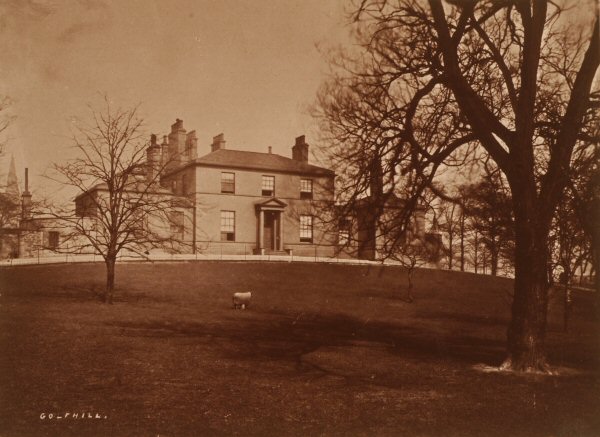

THE property of Alexander H. Dennistoun, Esq., is situated in the east end of Glasgow, immediately to the north-east of the Necropolis, and is approached by an old road which formerly led to the mill on the Wester Craigs lands, and which has long been known by the name of "Ark Lone."
The estate now known as Golfhill (formerly Goufhill), was part of the lands of Wester Craigs which originally belonged to "James Hamiltoune, Bischope of Argyll, and sub-dean of ye Metropolitane Kirk of Glasgow." They afterwards came into the hands of the Stewarts of Mynto, and were sold, in 1650, by Sir Ludovic of that family, to the Merchants' House of Glasgow.
In 1756, Golfhill, along with some other parts of Wester Craigs, was bought from the House by John Anderson, merchant in Glasgow, who almost immediately transferred it to his brother, Jonathan Anderson, a wealthy Glasgow merchant. (1) In 1802 his trustees sold the property to James Dennistoun, merchant in Glasgow - who immediately afterwards built the present house.
James Dennistoun was a very well known and highly-respected citizen of Glasgow. He was born at Campsie in 1758, and, coming to Glasgow, he soon acquired a leading position as a merchant, and in 1806-7 was a magistrate of the City. It was, perhaps, however, as a banker, that he was most famous, and under his liberal and judicious management the "Glasgow Bank," which was formed in 1809, soon gained the high position which it maintained to the last. (2) James Dennistoun continued at the head of this bank till 1829, and when he retired, his fellow-citizens, to mark their sense of the value of his services, gave, him a magnificent banquet in the Royal Exchange. He died in 1835. His son, Alexander Dennistoun, merchant in Glasgow and formerly M.P. for the county of Dumbarton, succeeded to the property. (3) He largely increased his estate by the purchase of Whitehill, Craigpark, and other lands adjoining Golfhill, and the whole is now formed into an eastern suburb, which named "Dennistoun." (4) At his death his son succeeded. (5)
(1) "View of the Merchants' House of Glasgow," p. 515, contains a most interesting account of the lands of Easter and Wester Craigs, from the pen of the well known archaeologist, John Buchanan, LL.D., of Glasgow.
(2) The office of this bank was at the corner of Montrose Street and Ingram Street. Its business was afterwards taken over, along with that of other private banks, by the Union Bank of Scotland, which originally started in 1830, under the title of the Glasgow Union Banking Co.
(3) John Dennistoun, his other son, was also a merchant in Glasgow, and for many years represented the city in Parliament. He left two sons, James, at present in Australia, and John, a merchant in London, and a daughter, Constance, who married John Hamilton, son of William Hamilton of Northpark. She is now a widow.
(4) This new suburb of Dennistoun must not be confused with an old dismembered barony in Renfrewshire, which gives its name to another family of Dennistouns long connected with Glasgow, and whose late representative, James Dennistoun of Colgrain, was, in 1825, authorized to assume the style of Dennistoun of Dennistoun. The present Dennistoun of Dennistoun (James Wallis Dennistoun) was formerly in the Royal Navy, but retired some years ago, and at present resides in Selkirkshire.
(5) Alexander H. Dennistoun of Golfhill married in 1852 Georgina-Helena, daughter of Sir Charles Oakley, Bart., and has issue. Besides his son Alexander, now of Golfhill, the late Alexander Dennistoun had two other sons, Robert and Walter, who both died unmarried, and two daughters, of whom the elder, Eleanor, married Professor Sellar, of the University of Edinburgh, and the younger, Elizabeth, married Mr. Seton Thomson of Glasgow.
Back to Contents